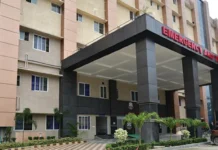Monday Musing
[ Amar Sangno ]
Globally, humankind is experiencing an extraordinary situation – it is as if we were in a biological fiction Hollywood movie – ever since Covid-19 broke out. In Arunachal, the month-long lockdown has cracked our fault lines wide open – in particular our healthcare system and the agriculture and allied sectors.
This crisis shows how weak our logistic preparedness has been, and how we should have realized this long before the pandemic hit us. Even after three decades of attaining statehood, our healthcare system remains pathetic. We have only two 100-bedded hospitals in the state – Tomo Riba Institute of Health & Medical Sciences (TRIHMS) in Naharlagun, and Bakin Pertin General Hospital in Pasighat – without intensive care units (ICU) and MRI facilities.
The health department is now scrambling around in panic, procuring ventilators for TRIHMS amid the Covid-19 crisis. Those who require better healthcare facilities are compelled to go outside the state. What if Assam and Meghalaya refuse to treat Arunachalee patients in their hospitals?
This extraordinary crisis has also laid bare how dependent we are on Assam for everything. Even though the chief secretary said that Arunachal has enough stocks of food grains, it is a fact that barely half of the state’s population depends on government stocks. They purchase essential items and groceries from the open markets, and the prices of these items are now skyrocketing. Shopkeepers are openly hoarding, despite the occasional ‘action’ taken by the district administrations.
This crisis has taught some hard lessons to our citizens, who are supposedly in pursuit of making Arunachal a self-reliant state. Our state’s economy is largely agrarian, based on terrace cultivation of rice and cultivation of crops such as maize, millet, wheat, pulses, sugarcane, ginger, oilseeds, cereals, potatoes, and pineapples.
Though Arunachal is the largest state in the Northeast in terms of area, the total paddy production in the state in 2019 was 3,60,000 metric tons (mt) against the requirement of 4,68,000 mts. Out of this, jhum cultivation contributed 50,000 mts. Maize production was 78,000 mts, millet 27,000 mts, and pulses 13,000 tons.
Official sources said there are 75,880 registered farmers in the state as of April 2020, out of a population of 13.84 lakhs.
Over the years, jhum/shifting cultivation has been drastically reduced, resulting in a rise in consumption of PDS rice among the villagers. There was a time when the people living in the rural areas never depended on the public distribution system (PDS) for survival. However, today, it is likely that the people would starve in the absence of PDS rice.
“Farmers are lazy to go for double cropping. They mainly take up one-season crops. The cropping intensity is nil. The land remains barren and unused throughout the year. Double-cropping not only increases food production but also the farmer’s income,” said Joymoni Beyong, agriculture development officer in East Kameng HQ Seppa, citing the reason behind the low agricultural production.
Agriculture experts suggest area expansion, creation of irrigation facilities, double-cropping in the vast foothill areas, replacement of old varieties of crops with high-yielding varieties, etc, as key to improve agricultural production.
On the other hand, the fact that major projects and construction activities come to a standstill whenever the migrant workers leave en masse is testimony to our people’s dependence syndrome. Arunachal’s growth is almost entirely dependent on workforce imported from Assam and West Bengal. Meanwhile, our school dropout youths would much rather be volunteers and campaigners during student union elections and forming organizations than seek to become skilled workers.
We need to suture these fault lines at the policymaking level, focusing on revamping our healthcare system, skilling our youths, and augmenting our agriculture and allied sectors. It is always better late than never.





